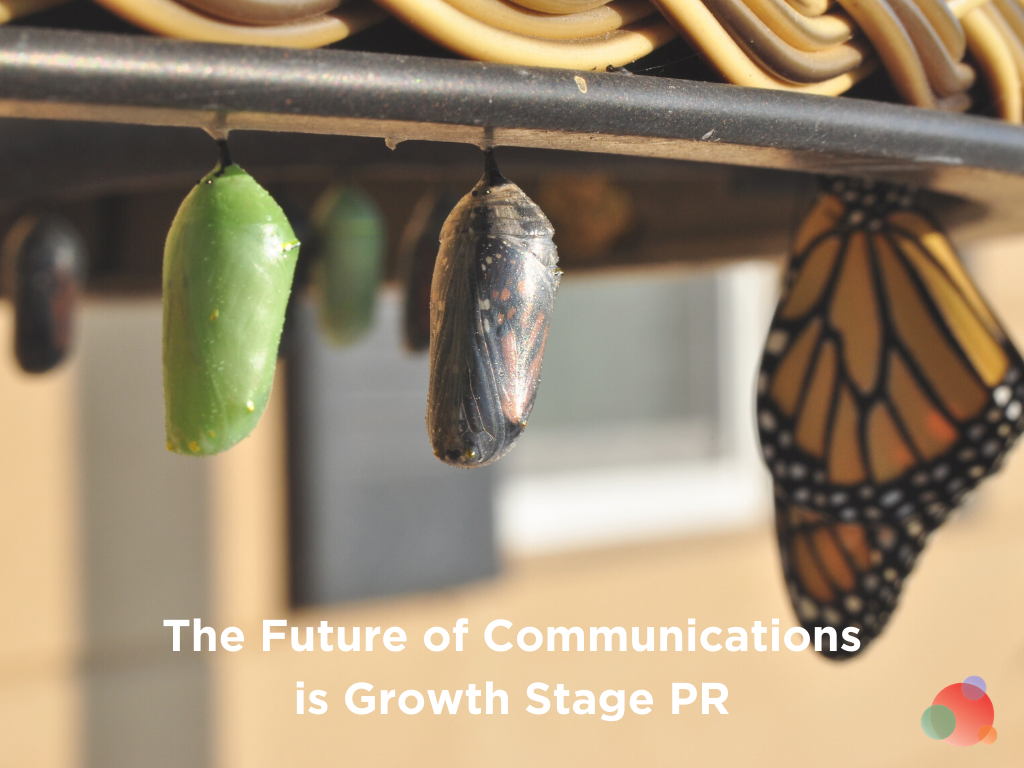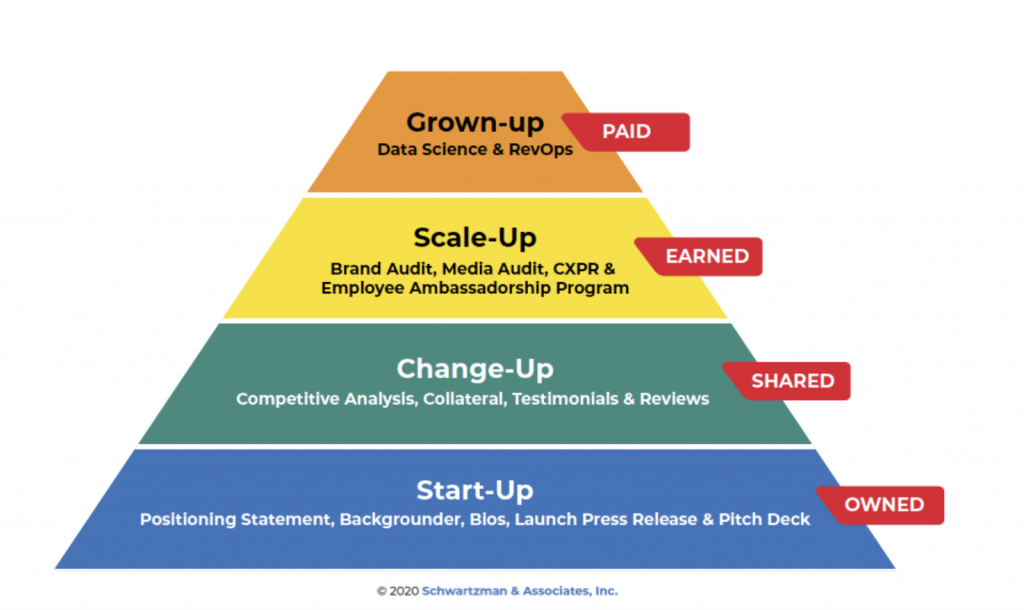
What if growth hacking was more important to clients than sector or media relations expertise?
Could you practice growth stage PR?
As we enter a new decade, your client’s priorities may be driven more by their stage of corporate development and growth targets than by their membership in an industry sector or tribe.
The lightning-fast path Google, Facebook, Linkedin, Airbnb, and Uber took to becoming massively valuable companies is not an accidental one.
More than anything else, navigating the scale-up stage in winner-take-all markets is what creates unicorns.
There is a lot which PR people can learn about how the strategic communications needs of a company change as it ascends from start-up to change-up to scale-up to grown-up.
It’s time we looked at how a company’s strategic communications needs map to the different growth stages they may be in.
Four Levels of Growth Stage PR
Maslow’s Hierarchy of Needs is a five-tier model organizing human needs from the bottom up.
It begins with physiological needs such as food, shelter, and water.
These needs must be met before we are ready for higher levels like safety, esteem, and self-actualization.
Strategic communications will never be a paint-by-the-numbers job, but companies do have different requirements at different stages.
There are exceptions of course, as Maslow himself acknowledges.
For instance, you don’t necessarily need to satisfy each stage 100% before moving to the next level.
If you consider a company’s strategic communications needs based on where they are on the growth curve, there are plenty of generalizations you can make.
For example, a start-up needs capital to operate.
It would be impossible for a company to progress to growth, alignment, or profitability stages without money to pay the bills.
Likewise, it would be strategically unwise to build out an employee ambassador program or hunt for testimonials before nailing a product-market fit.
Hierarchy of Strategic Communications Needs and the PESO Model
Applying Maslow’s scheme to the business of strategic communications suggests a similar framework with growth stage PR.
That includes front line initiatives most likely to apply, and the logical order for introducing media channels.
As you can see in the chart below, there is a natural alignment with the PESO model.

Start-ups and Change-ups
Start-ups need a positioning statement to explain how they intend to fulfill a customer need in a way their competitors can’t.
They should survey the competitive landscape to help discover how best to communicate their niche.
But that positioning statement will change once you engage customers and move from start-up to change-up or “pivot” stage.
“Any product you’ve carefully refined, based on your instincts rather than real user reactions and data, is likely to miss the mark,” says Reid Hoffman in his book Blitzscaling.
On the other hand, start-ups and change-ups aren’t ready for brand audits.
They’re too new. so there’s no digital breadcrumb trail to analyze.
Scale-ups and Grown-ups
Organizations in the scale-up and grown-up phases use brand audits to benchmark their performance against competitors and fine-tune their positioning.
Scale-ups are focused on CXPR, discreet communications mapped to various parts of the customer journey.
And grown-ups are analyzing data from the lead to revenue path to continually improve conversions and circumvent churn.
In his book Outside Insight, Jorn Lyseggen analyzes the boilerplate section of Apple’s news releases over time to see how the company’s positioning evolved:
The reason why the boilerplate is interesting is that it gives a very condensed description of what the company does or aspires to do. And it is usually limited to a few sentences.
Studying the boilerplate in Apple’s press releases is a fascinating read, capturing 15 years of consumer technology history. Apple is highly structured in its approach, consistently using two to three sentences to describe its business. Tracking the development from year to year, we can see how the tech company’s strategy and product focus has evolved from computers to personal computing devices.
Of course, start-ups and change-ups don’t have 15 years of news releases to analyze.
A Progressive Communications Plan
The necessity for updating positioning statements never goes away.
But inventing that language from scratch is a much different exercise than updating it periodically.
Overinvesting in a position statement that isn’t market-tested is a waste of time.
Because it’s likely going to change anyway.
Managing strategic communications through start-up to change-up stages is perhaps the most challenging since the client is still searching for their go-to-market strategy.
But it is also the most rewarding.
“Fans stick around while you pivot and customers churn,” David Meerman Scott, author of the new book Fanocracy, told me during a recent PR Tech Wednesday webinar.
Just as the stages of development on Maslow’s hierarchy of needs are progressive, an organization’s strategic communications needs depend on its growth path.
This suggests developing a logically ordered strategic communications plan based on this hierarchy of needs and the PESO Model.
Which makes sense since the process of PR itself is sequential.
Workflow-Oriented PR Automation
According to Intrado president, Ben Chodor, his firm’s recent acquisition of PR automation solution Notified, was driven largely by its workflow-oriented approach.
This tool divides the public relations process into five phases: listen, connect, publish, amplify, and measure.
This is a common media relations-oriented workflow and can support organizations of all sizes.
But for start-ups and change-ups still honing their message, listening and connecting is their focus.
While scale-ups and grown-ups will be concentrating on publishing, amplifying, and measuring.
Sector Experience vs. Growth Stage PR
Recognizing an organization’s position on the hierarchy of strategic communications needs calls for a new way of assessing public relations staffing.
Traditionally, when clients shop for PR agencies, most gravitate to firms with experience in their sector.
More and more scale-ups are putting growth before efficiency, despite uncertainty.
But finding PR specialists with experience at organizations that increase in size every year is becoming more important than media relations expertise in a given industry.
When NYC-based real estate scale-up SquareFoot brought PR in-house, they hired internally rather than seeking out a media relations pro with commercial real estate expertise.
They brought on Danny Groner, a journalist turned media relations pro, who joined Shutterstock pre-IPO and stayed through multiple acquisitions.
“He’s our growth PR specialist, and it’s really important those two words are in there, in that order. His number one job is growth, and he uses PR to help accomplish this,” says Jonathan Wasserstrum, CEO of SquareFoot.
User growth is easily verifiable. Whereas alleged relationships with media in a vertical industry are tougher to prove.
“Every agency’s going to say they have sector experience, but you can’t really put that to the test very easily. So I wouldn’t put a ton of stock in that,” said Convince and Convert CEO, Jay Baer.
Embrace the Hierarchy of Strategic Communications Needs
Once you appreciate the logical hierarchy of strategic communications needs, the Maslovian logic of the business of growth stage PR becomes clear right away.
And then, you can intentionally organize your strategic communications plan to support rapid growth.
Venture capitalists who have invested and enjoyed the returns of fast-growing companies know this well.
“Only spend money to fix things on the critical path to reaching the next phase of scale; everything else can wait,” says Hoffman, providing a good rule of thumb for which public relations activities make sense at different growth stages.
Unfortunately, not all companies are able to progress upward in a straight line.
Bad behavior, data breaches, and rumors may hold communicators hostage at various stages of the hierarchy of strategic communications.
It is important to understand which strategic communications initiatives to conduct at different stages of growth.
This fortifies your odds of reaching the stars.
Do you want to learn how to implement the PESO model to achieve unparalleled communications results? You can watch our FREE masterclass by clicking the button below.
Watch PESO Model 2.0 Masterclass Now
Photo by Suzanne D. Williams on Unsplash